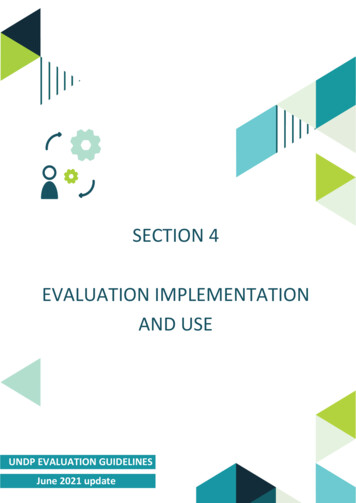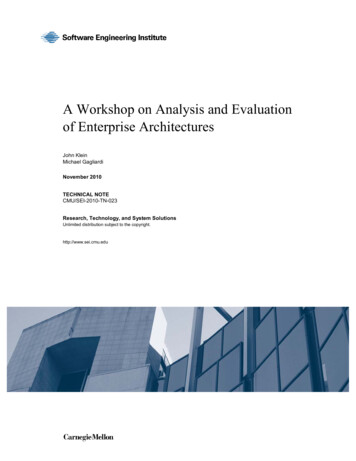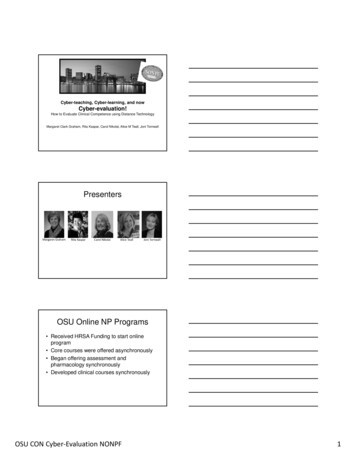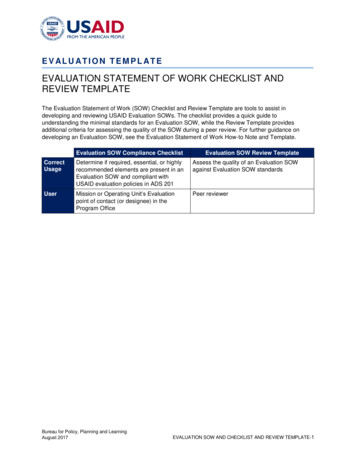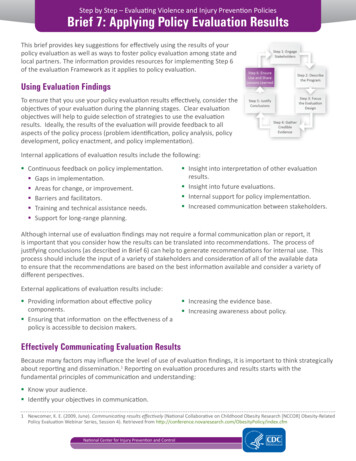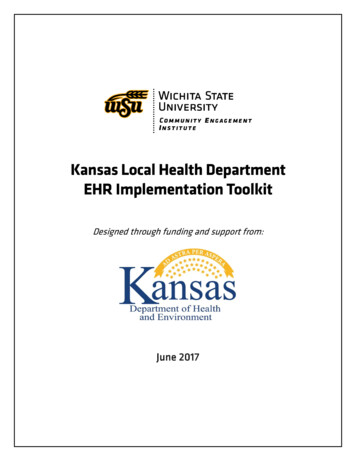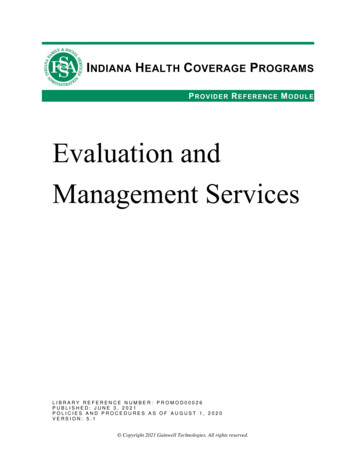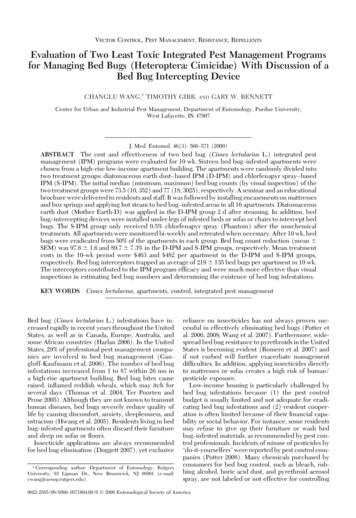
Transcription
VECTOR CONTROL, PEST MANAGEMENT, RESISTANCE, REPELLENTSEvaluation of Two Least Toxic Integrated Pest Management Programsfor Managing Bed Bugs (Heteroptera: Cimicidae) With Discussion of aBed Bug Intercepting DeviceCHANGLU WANG,1 TIMOTHY GIBB,ANDGARY W. BENNETTCenter for Urban and Industrial Pest Management, Department of Entomology, Purdue University,West Lafayette, IN 47907J. Med. Entomol. 46(3): 566Ð571 (2009)ABSTRACT The cost and effectiveness of two bed bug (Cimex lectularius L.) integrated pestmanagement (IPM) programs were evaluated for 10 wk. Sixteen bed bugÐinfested apartments werechosen from a high-rise low-income apartment building. The apartments were randomly divided intotwo treatment groups: diatomaceous earth dustÐ based IPM (D-IPM) and chlorfenapyr sprayÐ basedIPM (S-IPM). The initial median (minimum, maximum) bed bug counts (by visual inspection) of thetwo treatment groups were 73.5 (10, 352) and 77 (18, 3025), respectively. A seminar and an educationalbrochure were delivered to residents and staff. It was followed by installing encasements on mattressesand box springs and applying hot steam to bed bugÐinfested areas in all 16 apartments. Diatomaceousearth dust (Mother Earth-D) was applied in the D-IPM group 2 d after steaming. In addition, bedbugÐintercepting devices were installed under legs of infested beds or sofas or chairs to intercept bedbugs. The S-IPM group only received 0.5% chlorfenapyr spray (Phantom) after the nonchemicaltreatments. All apartments were monitored bi-weekly and retreated when necessary. After 10 wk, bedbugs were eradicated from 50% of the apartments in each group. Bed bug count reduction (mean SEM) was 97.6 1.6 and 89.7 7.3% in the D-IPM and S-IPM groups, respectively. Mean treatmentcosts in the 10-wk period were 463 and 482 per apartment in the D-IPM and S-IPM groups,respectively. Bed bug interceptors trapped an average of 219 135 bed bugs per apartment in 10 wk.The interceptors contributed to the IPM program efÞcacy and were much more effective than visualinspections in estimating bed bug numbers and determining the existence of bed bug infestations.KEY WORDS Cimex lectularius, apartments, control, integrated pest managementBed bug (Cimex lectularius L.) infestations have increased rapidly in recent years throughout the UnitedStates, as well as in Canada, Europe, Australia, andsome African countries (Harlan 2006). In the UnitedStates, 29% of professional pest management companies are involved in bed bug management (Gangloff-Kaufmann et al. 2006). The number of bed buginfestations increased from 1 to 87 within 26 mo ina high-rise apartment building. Bed bug bites causeraised, inßamed reddish wheals, which may itch forseveral days (Thomas et al. 2004, Ter Poorten andProse 2005). Although they are not known to transmithuman diseases, bed bugs severely reduce quality oflife by causing discomfort, anxiety, sleeplessness, andostracism (Hwang et al. 2005). Residents living in bedbugÐinfested apartments often discard their furnitureand sleep on sofas or ßoors.Insecticide applications are always recommendedfor bed bug elimination (Doggett 2007), yet exclusive1 Corresponding author: Department of Entomology, RutgersUniversity, 93 Lipman Dr., New Brunswick, NJ 08901 (e-mail:cwang@aesop.rutgers.edu).reliance on insecticides has not always proven successful in effectively eliminating bed bugs (Potter etal. 2006, 2008; Wang et al. 2007). Furthermore, widespread bed bug resistance to pyrethroids in the UnitedStates is becoming evident (Romero et al. 2007) andif not curbed will further exacerbate managementdifÞculties. In addition, applying insecticides directlyto mattresses or sofas creates a high risk of human/pesticide exposure.Low-income housing is particularly challenged bybed bug infestations because (1) the pest controlbudget is usually limited and not adequate for eradicating bed bug infestations and (2) resident cooperation is often limited because of their Þnancial capability or social behavior. For instance, some residentsmay refuse to give up their furniture or wash bedbugÐinfested materials, as recommended by pest control professionals. Incidents of misuse of pesticides by“do-it-yourselfers” were reported by pest control companies (Potter 2008). Many chemicals purchased byconsumers for bed bug control, such as bleach, rubbing alcohol, boric acid dust, and pyrethroid aerosolspray, are not labeled or not effective for controlling0022-2585/09/0566Ð0571 04.00/0 䉷 2009 Entomological Society of America
May 2009WANG ET AL.: BED BUG IPM IN APARTMENTSbed bugs. Some consumers seek chemicals for bed bugcontrol from internet vendors. Overall, there is a lackof knowledge among consumers not only about whatpesticides can be used for bed bug control but alsowhat nonchemical control options are available.Therefore, there is a critical need for developing effective and least toxic (i.e., use nonchemical optionsand insecticides with low toxicity to humans and otheranimals) bed bug management techniques.Nonchemical methods are always advocated as animportant part of bed bug management programs toreduce bed bug populations (Kells 2006, Doggett2007). Recommended methods include hygiene,physical removal, heat, steam, cold, and mattress encasements. Nonchemical tools are touted as beingboth more immediate and safer than insecticides (Potter et al. 2007). However, adoption of nonchemicalonly methods is dubious because they are thought toprovide minimal residual effect and are often expensive.Integrated pest management (IPM) strategies, integrating both chemical and nonchemical tactics, aregenerally recognized as potentially more effective andsustainable than chemical-only controls. However,speciÞc IPM techniques within an IPM strategy mayvary. In addition, data on the cost effectiveness of bedbug IPM programs are lacking. Availability of suchdata has been found to be a determining factor in thepublic adoption of IPM programs in public schools(Fournier et al. 2003). This is expected to be equallytrue in bed bug IPM implementation. The objective ofthis study is to evaluate the cost and effectiveness oftwo least toxic bed bug IPM strategies in apartments:(1) diatomaceous earth dust-based IPM (D-IPM),which included hand removal, bed bug interceptors,mattress encasements, hot steam, and diatomaceousearth dust, and (2) 0.5% chlorfenapyr-based IPM (SIPM), which included hand removal, mattress encasements, hot steam, and 0.5% chlorfenapyr spray, but nobed bug interceptors. The chemicals used in the IPMprograms have very low toxicity (diatomaceous earth)or reduced risk (chlorfenapyr) as recognized by theU.S. Environmental Protection Agency.Materials and MethodsStudy Site and Selection of Apartments. The studysite was a 15-story apartment building located in Indianapolis, IN. The building had 225 one-bedroomapartments occupied by low-income elderly or disabled people. The Þrst bed bug infestation was reported to the management ofÞce in December 2005.Approximately 87 apartments experienced bed buginfestations as of February 2007.A careful visual inspection was conducted in apartments with reported bed bug infestations. In eachapartment, the bed was disassembled and thoroughlyinspected with the aid of a ßashlight and forceps.Other upholstered furniture, wheelchairs, perimetersof the ßoors, curtains, and boxes stored under the bedor in the closets were inspected for bed bugs. Sixteenapartments with at least 10 bed bugs per apartment567were identiÞed. Eight of them never received treatment before this study. Three apartments weretreated by a pest control contractor with pyrethroidspray and dust 2Ð 4 wk before our survey. Residentsapplied pyrethroid aerosol spray, bleach, or boric aciddust in eight apartments. In addition, four residentsdiscarded their infested beds and used a sofa or airmattress as a bed. One resident replaced his beds threetimes during the 6-mo period. The 16 apartments wererandomly assigned into one of the following twogroups: D-IPM and S-IPM. Detailed number of bedbugs (excluding eggs) and their distribution patternwere recorded.Treatment Protocol. Within a week after inspection, mattress encasements (Protect-A-Bed, Northbrook, IL) were installed over mattresses and boxsprings in 14 apartments. Two apartments did notreceive encasements because no bed or only an airmattress was in the apartments. After encasement installation, hot steam was applied to bed frames, ßoorsunder the beds, perimeter of the ßoor, sofas, and otherinfested furniture in all 16 apartments. Two steammachines were used: Steamy 4100 (Hi-Tech CleaningSystems, Columbus, OH) and Ladybug XL2300 (Advanced Vapor Technologies, Edmonds, WA). Bed linens were placed in plastic bags and the residents wereasked to launder them. Residents were also advised toboth launder their bedding materials weekly and reduce clutter as part of the bed bug management program.In the D-IPM group, bed bug interceptors wereinstalled under infested bed frame legs and/or sofalegs to intercept bed bugs traveling between the furniture and the ßoors. The bed bug interceptors consisted of two plastic bowls (Fig. 1). The large bowl(IKEA New Haven, New Haven, CT) was 6 cm highwith a 18-cm diameter at the bottom and a 15-cmdiameter at the top. Fabric was glued to its exteriorwall to allow bed bugs to climb the bed bug interceptors. The inner wall of the bowl was smooth. Bed bugsthat reached the top of the bowl were subject to fallinginto the bottom of the bowl, which contained 40 mlof 50% ethylene glycol as a killing agent. The smallbowl was a plastic container 7 cm high with a 9-cmbottom diameter and a 10.5-cm top diameter. Thesmall bowl was placed inside the large bowl andformed a trench between the large and the small bowl.The inner bottom of the small bowl was covered witha mixture of diatomaceous earth (50%) and talcumpowder (50%) as killing agent. Furniture legs wereplaced inside the small bowl. Bed bugs from the roomthat were trying to reach the human host on bed orsofa would climb the large bowl and fall into the killingagent (ethylene glycol). Bed bugs from furniturecrawling into the small bowl by furniture legs were notable to escape into the large bowl because of the smallbowlÕs hard smooth inner surface and talcum power(as an extra preventative measure).Diatomaceous earth (Mother Earth-D; WhitmireMicro-Gen Research Laboratories, St. Louis, MO) wasapplied to bed frames, sofa (the back, underside, andseams), along baseboards and molding, and electric
568JOURNAL OF MEDICAL ENTOMOLOGYVol. 46, no. 3Fig. 1. Bed bug interceptor placed under furniture legs for intercepting bed bugs traveling between the furniture andthe ßoor. (A) Top view of a bed bug interceptor that consisted of a small and a large plastic bowl; 40 ml 50% ethylene glycolwas in the large bowl as a killing agent; a mixture of diatomaceous earth (50%) and talcum powder (50%) was placed in thesmall bowl for killing bed bugs and preventing escape. (B) The small bowl was removed to show the bed bugs trapped inthe large bowl.outlets 2 d after steaming. The dust was not appliedimmediately after steaming to avoid potential loss ofefÞcacy because of moisture left by the steaming process.In the S-IPM group, 0.5% chlorfenapyr (Phantominsecticide; BASF, Research Triangle Park, NC) wasapplied to bed frames and headboards, along baseboards and molding, sofas and chairs (the back, underside, and seams), ßoors under the beds, and otherbed bug harborage areas (such as infested wheelchairsand curtains) immediately after steaming. No bed buginterceptors were installed under infested furniturelegs in this treatment group because some beds did nothave frames and our objective was to evaluate theeffectiveness of the two IPM programs.Additional hot steam, dust, or spray was applied asnecessary during 2-, 4-, 6-, 8-, and 10-wk follow-upinspections except for the last inspection. Two orthree entomologists (the authors and two researchassistants) worked together in each apartment. Thoseapartments adjacent to the test apartments were monitored and treated monthly by the existing pest controlcontractor.Program Evaluation. The test apartments were visually reinspected at 12- to 18-d intervals for 10 wkafter the initial treatment. Bed bugs discovered duringthese inspections were either hand removed (withforceps) or killed with hot steam. The number of bedbugs in bed bug interceptors was recorded, and thesewere removed during each bi-weekly inspection. Thetechnician time (time in an apartment multiplied bythe number of technicians) spent for servicing eachapartment was recorded.The costs of materials and labor were estimatedusing the following rates: encasements, 100/set (fora full-size mattress and box spring); diatomaceousearth dust, 0.025/g; chlorfenapyr, 0.671/liter; bedbug interceptors, 2/bed bug interceptor; labor, 60/h. The cost for hot steaming was negligible andnot included in calculating the IPM program cost.Data Collection and Analysis. The service time,initial bed bug counts (logarithmic transformed), andnumber of hot steam or chemical applications werecompared between the two IPM groups using analysisof variance (ANOVA; SAS Institute 2003). Effect ofthe two IPM strategies on visual counts (cube roottransformed) was evaluated using repeated measurement analysis and the initial count as covariant. Similarly, the effectiveness of the two IPM strategies wascompared with the chemical-only (cyßuthrin dust anddeltamethrin spray) strategy that was conducted onthe same property by the same research team (Wanget al. 2007). Five apartments that had 10 bed bugsfrom the 2007 study were included. The difference ofbed bug counts between large and small bowls of thebed bug interceptors and differences between visualinspection counts and bed bug interceptor counts ineach apartment were compared using the StudentÕst-test (SAS Institute 2003).ResultsInitial Bed Bug Counts and Distribution. The initialvisual inspection identiÞed 16 heavily infested apartments. These were randomly divided into two groups.The median (minimum, maximum) counts were 73.5(10, 352) in the D-IPM group and 77 (18, 3025) in theS-IPM group. The mean counts (mean SEM) were103 38 and 507 366, respectively, and were notsigniÞcantly different from each other (F 0.79; df 1,14; P 0.39).The average relative abundance of bed bugs bylocation was as follows: mattress, 22%; box spring, 60%;bed frame, 4%; sofa and chair, 13%; other areas, 1%.Effectiveness of the IPM Treatments. Figure 2shows the bed bug count (by visual inspection) reduction after the IPM implementation. D-IPM resulted in signiÞcantly greater mean count reductionthan S-IPM (F 3.9; df 10,69; P 0.001). At week2, both treatments resulted in 74% count reduction.
May 2009WANG ET AL.: BED BUG IPM IN APARTMENTSFig. 2. Bed bug count reduction (mean SEM) afterimplementation of D-IPM and S-IPM in apartments.By week 10, mean bed bug count reduction by D-IPMand S-IPM were 97.6 1.6 and 89.7 7.3%, respectively. Bed bugs were eradicated (based on visualinspections and resident interviews) from 50% of theapartments in both groups. The maximum numbers ofbed bugs found in each apartment at week 10 was 4and 32 in the D-IPM and S-IPM groups, respectively.Effectiveness of Bed Bug Interceptors for DetectingBed Bug Infestations and Reducing Bed Bug Numbers. Many more bed bugs were trapped in bed buginterceptors than were discovered through visual inspections (Table 1; Fig. 3). The mean bed bug countsper apartment from bed bug interceptors (10 wk trapping period) and visual inspections (Þve bi-weeklyinspections) were 219 135 and 39 22, respectively.The bed bug interceptor counts were signiÞcantlyhigher than the visual counts (t 7.0; df 7; P 0.001).The large and small plastic bowls comprising thebed bug interceptors caught an average of 207 127and 13 8 bed bugs in each apartment. In eachapartment, there were signiÞcantly more bed bugs inlarge bowls than in the small bowls (t 7.6; df 7; P 0.001), indicating there were more bed bugs from therooms off the beds and sofas than those on the bedsand sofas after the initial treatment (installing encasements, steaming, and applying insecticides). Based onthe total bed bug numbers found through initial visualinspection and cumulative counts in bed bug interceptors, the mean (minimum, maximum) percentageTable 1.569Fig. 3. Bed bug counts from visual inspections and bedbug interceptors in eight apartments.of bed bugs on beds and sofas was 56% (23, 88%) at thebeginning of the study.Cost of the IPM Programs. There were no signiÞcant differences in the mean number of steam andchemical applications and mean service time betweenthe two IPM strategies (Table 2). A total of 319 g ofdiatomaceous dust (D-IPM) and 16 liters of 0.5%chlorfenapyr spray (S-IPM) were applied. The average insecticide cost per apartment was only 1.01 forthe dust and 1.35 for the spray. Thus, the vast majorityof the included cost was technician time and mattressencasements. For apartments that received one set ofencasements, the mean IPM program cost was 463and 482 per apartment in the D-IPM and S-IPMgroups, respectively.DiscussionResults from this study suggest several importantconsiderations in bed bug management: (1) bed buginterceptors are a valuable tool for estimating bed bugpopulations, reducing bed bug numbers, and providing immediate relief to residents from bed bug bites;(2) IPM regimens such as those used in this studyreduce pesticide use and human/insecticide exposurerisks; (3) effective residual insecticides are needed forbed bug elimination; (4) multiple inspections andtreatments are necessary to eradicate bed bug infestations.Comparison of bed bug counts from visual inspections and bed bug interceptorsTotal bed bug counts in 10 wkApartmentNo. bed buginterceptorsFurniture typeBed buginterceptorsVisual inspection(total of Þve inspections)12345678108444486Bed, sofaBed, sofaBedBedBedBedBed, chairSofaa4114121388904311031022163227166aThe bed was discarded by resident in this apartment.
570JOURNAL OF MEDICAL ENTOMOLOGYTable 2. Treatment information of the two bed bug IPM programs over 10 wkTreatment informationD-IPMS-IPMNumber of hot steam applicationsNumber of chemical applicationsTotal technician time (min)2.3 0.5a2.6 0.3a346 57a2.6 0.5a2.5 0.3a381 47aValues are mean SEM. Means in the same row followed by thesame letters indicate no signiÞcant differences (P 0.05).Bed bug interceptors placed under furniture legsprovided a mechanical barrier to bed bugs travelingbetween the ßoor and the furniture. Metal cans andglass containers were used in the early 1900s to reducebed bug bites (Pinto et al. 2007). We found one resident placed oil-Þlled metal cans under bed legs toprevent bed bug bites during our Þeld inspectionsbefore this study. Adding cloth to the bed bug interceptors in this study enabled bed bugs to climb the bedbug interceptors and become trapped. The bed buginterceptor provided both protection of humans frombed bug bites and detection of bed bugs. In addition,the interceptor design allows for determination ofrelative number of bed bugs traveling to the furnitureand from the furniture.The furniture legs had various shapes, and somesofas rested directly on the small bowls of the bed buginterceptors. Some sofas had loose ßaps of fabric thattouched the large bowl. In addition, some residentsplaced clothes or bed linens against the wall, formingbridges for bed bugs to access the bed or sofa from theßoor to the furniture. These conditions impaired thefull effect of the interceptors and may have contributed to the reappearance of bed bugs on furniture.Another interesting Þnding from this study is thatthere were many more bed bugs from off the bed andsofa than previously thought. Visual inspections in thisstudy and earlier studies in apartments found 85% ofthe bed bugs were on beds and sofas (Potter et al. 2006,2008; Wang et al. 2007). By comparing results of bothvisual inspection and bed bug interceptors in thisstudy, we found only 56% of the bed bugs were on bedsand sofas. The actual distribution on furniture mightbe even lower because the insecticides and hot steammight have killed much more bed bugs in the roomthan those counted by visual inspections. This Þndingimplies that pest management professionals must payequal attention to furniture and other areas (such asbaseboards, dressers, and clutter around the beds andsofas) in an infested room when conducting inspections and treatments.All live bed bugs found during inspection wereremoved or killed with hot steam. However, manymore bed bugs were trapped in bed bug interceptorsafterward, indicating that visual inspection was only atool for estimating bed bug populations. Bed bugswere found in bed bug interceptors from two of the“eradicated” apartments (based on visual inspections)between weeks 8 and 10 (one and two bed bugs ineach apartment, respectively). Thus, bed bug interceptors are very useful for detecting low numbers ofVol. 46, no. 3bed bugs and eliminating bed bug populations. Furthermore, it is much easier, economical, and less intrusive to install interceptors than to conduct laborious visual inspections.The IPM programs included mattress encasementsand hot steam in an attempt to reduce insecticide useand improve control efÞcacy. Compared with thechemical-only treatment (pyrethroid dust and spray)conducted in the same apartment complex (Wang etal. 2007), the D-IPM resulted in a similar level of bedbug population reduction (F 0.02; df 1,43; P 0.08); the S-IPM resulted in signiÞcantly lower population reduction (F 10.1; df 1,43; P 0.01).Interceptors might have had substantial impact on thedifferences in effectiveness of the two IPM regimens.Potter et al. (2008) reported chlorfenapyr spray aloneeradicated bed bugs from one third of the apartmentsafter 12 wk. In our study, a combination of chlorfenapyr and nonchemical tools resulted in eradicationfrom 50% of the apartments after 10 wk.Compared with the chemical-only treatment(Wang et al. 2007), the D-IPM reduced dust use by19% and avoided the use of spray. The S-IPM reducedspray use by 30% and avoided the use of dust. Compared with the chemical treatment reported by Potteret al. (2006), the S-IPM reduced insecticide spray (forthe initial treatment) by 83%. Compared with chlorfenapyr-alone treatment by Potter et al. (2008), theS-IPM reduced chlorfenapyr use (for the initial treatment) by 62%. More importantly, no chemicals wereapplied to mattresses and box springs in both IPMprograms, thus reducing the risk of human/insecticideexposure. For asthma patients who are allergic to indoor allergens, the encasements and hot steam wereanticipated to be helpful in relieving their asthmasymptoms by reducing allergens on bed or ßoors. Additional beneÞts of installing encasements and applying hot steams were discussed by Pinto et al. (2007).Even with multiple tools and bi-weekly monitoringand treatments, bed bugs were not eradicated in 50%of the infested apartments after 10 wk. We observedbed bugs covered with diatomaceous earth residueson a very thoroughly treated sofa. We also noticed bedbugs at a corner of an infested bedroom ßoor after twochlorfenapyr spray applications (4 wk apart). However, pest control companies reported successful control of bed bugs with a combination of chlorfenapyrspray and DE dust or pyrethroid dust (J. Black, personel communication). Field studies evaluating theefÞcacy of registered bed bug control chemicals arerare. Such studies would be extremely helpful fordesigning effective bed bug management programs.This study was not designed to compare DE and chlorfenapyr. We were interested in evaluating the effectiveness of two IPM programs. Therefore, we couldnot draw any conclusions on the relative effectivenessof the two insecticides. How to effectively incorporateresidual insecticides, especially low-risk chemicals,into bed bug IPM programs needs to be studied withthe goal of rapid bed bug eradication.This study conÞrmed that managing bed bug infestations in apartments is a difÞcult and expensive task.
May 2009WANG ET AL.: BED BUG IPM IN APARTMENTSThe cost will be even higher for treating apartmentswith multiple beds. Follow-up monitoring and treatments are necessary (Pinto et al. 2007, Potter 2008).ResidentsÕ attitudes toward bed bug infestations varied greatly. Many of the residents involved in thisstudy were not aware of and/or were not concernedabout bed bug infestations. At the end of this study,none of the residents complained about bed bug bites.However, 50% of the apartments still had bed bugs.Thus, relying on resident reporting and interviews willnot provide accurate information on bed bug infestations. Many residents did not or were unable to washbed bugÐinfested linens and reduce clutter. One resident did not like our frequent visits and treatments,despite her bed bug infestation. She brought in a bedbugÐinfested chair during our study, which contributed to the eradication failure in her apartment.Bed bugÐinfested medical equipment (wheelchairs,walkers) was frequently used by residents in commonareas of the building. We found bed bugs in stickytraps placed in the hallways and signs of bed bugs onsofas in the common area of the building. Without abuilding-wide intensive IPM implementation, including education and remotivation of residents and activestaff participation in monitoring and assisting withIPM implementation, any existing bed bug infestationwill persist and spread within the community and toother communities.AcknowledgmentsWe thank E. Chin, M. A. El-Nour, and the Indiana Housing Agency staff for assisting with the Þeld work; R. Cooperfor advice in designing the IPM programs; Protect-A-Bed fordonating encasements; High-Tech Cleaning Systems forloaning a steam machine; BASF and Whitmire Micro-GenResearch Laboratories for donating products; L. Shu forassisting with statistical analysis; and K. Seikel and S. McKnight for reviewing an earlier draft of the manuscript. Weare especially grateful to S. McKnight for designing andproviding the bed bug interceptors. This research was sponsored by U.S. Department of Agriculture North Central IPMCenter and BASF. This is Journal Article 2008-18370 of theAgricultural Research Program of Purdue University, WestLafayette, IN.571References CitedDoggett, S. 2007. A code of practice for the control of bed buginfestations in Australia. (http://medent.usyd.edu.au/bedbug/bedbug cop.htm).Fournier, A., F. Whitford, T. J. Gibb, and C. Y. Oseto. 2003.Protecting U.S. school children from pests and pesticides.Pestic. Outlook. 14: 36 Ð39.Gangloff-Kaufmann, J., C. Hollingsworth, J. Hahn, L. Hansen, B.Kard, and M. Waldvogel. 2006. Bed bugs in America: a pestmanagement industry survey. Am. Entomol. 52: 105Ð106.Harlan, H. J. 2006. Bed bugs 101: the basics of Cimex lectularius. Am. Entomol. 52: 99 Ð101.Hwang, S. W., T. J. Svoboda, I. J. De Jong, K. J. Kabasele, andE. Gogosis. 2005. Bed bug infestations in an urban environment. Emerg. Infect. Dis. 11: 533Ð538.Kells, S. A. 2006. Nonchemical control of bed bugs. Am.Entomol. 52: 109 Ð110.Pinto, L. J., R. Cooper, and S. K. Kraft. 2007. Bed bug handbook: the complete guide to bed bugs and their control.Pinto and Associates, Mechanicsville, MD.Potter, M. F. 2008. The business of bed bugs. Pest Manag.Professional 76(1): 24 Ð25, 28 Ð32, 34, 36 Ð 40.Potter, M. F., A. Romero, K. F. Haynes, and W. Wickemeyer.2006. Battling bed bugs in apartments. Pest ControlTechnol. 34: 44 Ð52.Potter, M. F., A. Romero, K. F. Haynes, and E. Hardebeck.2007. Battling bed bugs in sensitive places. Pest ControlTechnol. 35(1): 24 Ð25, 27, 29 Ð30, 32.Potter, M. F., K. F. Haynes, A. Romero, E. Hardebeck, and W.Wickenmeyer. 2008. Is there a new bed bug answer?Pest Control Technol. 36(6): 116, 118 Ð124.Romero, A., M. F. Potter, D. A. Potter, and K. F. Haynes.2007. Insecticide resistance in the bed bug: a factor inthe pestÕs sudden resurgence? J. Med. Entomol. 44:175Ð178.SAS Institute. 2003. SAS/STAT userÕs guide, version 9.1.SAS Institute, Cary, NC.Ter Poorten, M. C., and N. S. Prose. 2005. The return of thecommon bed bug. Pediatr. Dermatol. 22: 183Ð187.Thomas, I., G. G. Kihiczak, and R. A. Schwartz. 2004. Bedbug bites: a review. Int. J. Dermatol. 43: 430 Ð 433.Wang, C., M. Abou El-Nour, and G. W. Bennett. 2007. Controlling bed bugs in apartments: a case study. Pest ControlTechnol. 35(11): 64, 66, 68, 70.Received 1 July 2008; accepted 6 February 2009.
The interceptors contributed to the IPM program efÞcacy and were much more effective than visual inspections in estimating bed bug numbers and determining the existence of bed bug infestations. KEY WORDS Cimex lectularius, apartments, control, integrated pest management Bed bug (Cimex lectularius L.) infestations have in-





